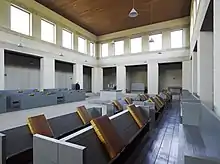 Triangles with sides in ratio form a closed spiral | |
| Rationality | irrational algebraic |
|---|---|
| Symbol | |
| Representations | |
| Decimal | 1.32471795724474602596... |
| Algebraic form | real root of |
| Continued fraction (linear) | [1;3,12,1,1,3,2,3,2,4,2,141,80,...] [1] not periodic infinite |
| Binary | 1.01010011001000001011... |
| Hexadecimal | 1.5320B74ECA44ADAC1788... |

In mathematics, the plastic number is a geometrical proportion close to 53/40. Its true value is the real solution of the equation .
The adjective plastic does not refer to the artificial material, but to the formative and sculptural qualities of this ratio, as in plastic arts.
Definition
Three quantities a > b > c > 0 are in the plastic ratio if
- .
The ratio is commonly denoted .
Let and , then from and
one has and , thus .
It follows that the plastic ratio is found as the unique real solution of the cubic equation The decimal expansion of the root begins as (sequence A060006 in the OEIS).
Using formulas for the cubic equation, one can show that
or, using the hyperbolic cosine,
is the superstable fixed point of the iteration .
Properties
The plastic ratio and golden ratio are the only morphic numbers: real numbers x > 1 for which there exist natural numbers m and n such that
- and . [4]
Morphic numbers can serve as basis for a system of measure.
Properties of (m=3 and n=4) are related to those of (m=2 and n=1). For example, The plastic ratio satisfies the infinitely nested radical
- ,
while for the golden ratio one has
- .
The plastic ratio can be expressed in terms of itself as the infinite geometric series
- ,
in comparison to the golden ratio identity
- .
Additionally, , while
For all powers
- .
The algebraic solution of a reduced quintic equation can be written in terms of square roots, cube roots and the Bring radical. If then . Since .
Continued fraction pattern of a few low powers
- (25/33)
- (45/34)
- (58/33)
- (79/34)
- (40/13)
- (53/13) ...
- (93/13) ...
- (88/7)
The plastic ratio is the smallest Pisot number.[5] Because the absolute value of both algebraic conjugates is smaller than 1, powers of generate almost integers. For example: . After 29 rotation steps the phases of the inward spiraling conjugate pair – initially close to ±45π/58 – nearly align with the imaginary axis.
The minimal polynomial of the plastic ratio has discriminant . Its splitting field over rationals is . This field is also the Hilbert class field of . Thus, can be expressed in terms of the Dedekind eta function with argument
- . [6]
Properties of the related Klein j-invariant result in near identity . The difference is < 1/12659.
Van der Laan sequence
In his quest for perceptible clarity, the Dutch Benedictine monk and architect Dom Hans van der Laan (1904-1991) asked for the minimum difference between two sizes, so that we will clearly percieve them as distinct. Also, what is the maximum ratio of two sizes, so that we can still relate them and percieve nearness. According to his observations, the answers are 1/4 and 7/1, spanning a single order of size.[7] Requiring proportional continuity, he constructed a geometric series of eight measures (types of size) with common ratio 2 / (3/4 + 1/71/7) ≈ ρ. Expressed in countable values, this architectonic system of measure consists of a subset of the numbers that bear his name.
The Van der Laan numbers have a close connection to the Perrin and Padovan sequences. In combinatorics, the number of compositions of n into parts 2 and 3 is counted by the nth Van der Laan number.
The Van der Laan sequence is defined by the third-order recurrence relation
- for n > 2,
with initial values
- .
The first few terms are 1, 0, 1, 1, 1, 2, 2, 3, 4, 5, 7, 9, 12, 16, 21, 28, 37, 49, 65, 86,... (sequence A182097 in the OEIS). The limit ratio between consecutive terms is the plastic ratio.
| k | n - m | err | interval | |
|---|---|---|---|---|
| 0 | 3 - 3 | 1 /1 | 0 | minor element |
| 1 | 8 - 7 | 4 /3 | 1/116 | major element |
| 2 | 10 - 8 | 7 /4 | -1/205 | minor piece |
| 3 | 10 - 7 | 7 /3 | 1/116 | major piece |
| 4 | 7 - 3 | 3 /1 | -1/12 | minor part |
| 5 | 8 - 3 | 4 /1 | -1/12 | major part |
| 6 | 13 - 7 | 16 /3 | -1/14 | minor whole |
| 7 | 10 - 3 | 7 /1 | -1/6 | major whole |
The first 14 indices n for which is prime are n = 5, 6, 7, 9, 10, 16, 21, 32, 39, 86, 130, 471, 668, 1264 (sequence A112882 in the OEIS).[8] The last number has 154 decimal digits.
The generating function of the Van der Laan sequence is given by
- for .[9]
The sequence is related to sums of binomial coefficients by
- .[10]
The characteristic equation of the recurrence is . If the three solutions are real root α and conjugate pair β and γ, the Van der Laan numbers can be computed with the Binet formula [10]
- for n > 2,
Since the magnitude of the two last terms is for all n > 4 and , the number is the nearest integer to , with .
The Van der Laan numbers are obtained as integral powers of the matrix
- with real eigenvalue .
Geometry

There are precisely three ways of partitioning a square into three similar rectangles:[11][12]
- The trivial solution given by three congruent rectangles with aspect ratio 3:1.
- The solution in which two of the three rectangles are congruent and the third one has twice the side length of the other two, where the rectangles have aspect ratio 3:2.
- The solution in which the three rectangles are all of different sizes and where they have aspect ratio ρ2. The ratios of the linear sizes of the three rectangles are: ρ (large:medium); ρ2 (medium:small); and ρ3 (large:small). The internal, long edge of the largest rectangle (the square's fault line) divides two of the square's four edges into two segments each that stand to one another in the ratio ρ. The internal, coincident short edge of the medium rectangle and long edge of the small rectangle divides one of the square's other, two edges into two segments that stand to one another in the ratio ρ4.
The fact that a rectangle of aspect ratio ρ2 can be used for dissections of a square into similar rectangles is equivalent to an algebraic property of the number ρ2 related to the Routh–Hurwitz theorem: all of its conjugates have positive real part.[13][14]
The circumradius of the snub icosidodecadodecahedron for unit edge length is
- . [15]
History and names

was first studied by Axel Thue in 1912 and by G. H. Hardy in 1919.[5] French high school student Gérard Cordonnier discovered the number for himself in 1924 and referred to it as the radiant number (French: le nombre radiant). Hans van der Laan gave it the name plastic number (Dutch: het plastische getal) in 1928.
Unlike the names of the golden and silver ratios, the word plastic was not intended by van der Laan to refer to a specific substance, but rather in its adjectival sense, meaning something that can be given a three-dimensional shape.[16] This, according to Richard Padovan, is because the characteristic ratios of the number, 3/4 and 1/7, relate to the limits of human perception in relating one physical size to another. Van der Laan designed the 1967 St. Benedictusberg Abbey church to these plastic number proportions.[17]
The plastic number is also sometimes called the silver number, a name given to it by Midhat J. Gazalé[18] and subsequently used by Martin Gardner,[19] but that name is more commonly used for the silver ratio one of the ratios from the family of metallic means first described by Vera W. de Spinadel in 1998.[20]
Martin Gardner has suggested referring to as "high phi", and Donald Knuth created a special typographic mark for this name, a variant of the Greek letter phi ("φ") with its central circle raised, resembling the Georgian letter pari ("Ⴔ").[21]
See also
- Solutions of equations similar to :
- Golden ratio – the only positive solution of the equation
- Supergolden ratio – the only real solution of the equation
Notes
- ↑ Sloane, N. J. A. (ed.). "Sequence A072117". The On-Line Encyclopedia of Integer Sequences. OEIS Foundation.
- ↑ Sloane, N. J. A. (ed.). "Sequence A060006". The On-Line Encyclopedia of Integer Sequences. OEIS Foundation.
- ↑ Tabrizian, Peyam (2022). "What is the plastic ratio?". YouTube. Retrieved 26 November 2023.
- ↑ Aarts, Jan; Fokkink, Robbert; Kruijtzer, Godfried (2001). "Morphic numbers" (PDF). Nieuw Archief voor Wiskunde. 5. 2 (1): 56–58. Retrieved 26 November 2023.
- 1 2 Panju, Maysum (2011). "A Systematic Construction of Almost Integers" (PDF). The Waterloo Mathematics Review. 1 (2): 35–43. Retrieved 29 November 2023.
- ↑ Weisstein, Eric W. "Plastic Constant". MathWorld.
- ↑ Voet, Caroline [in Dutch] (2019). "1:7 and a series of 8". The digital study room of Dom Hans van der Laan. Van der Laan Foundation. Retrieved 28 November 2023.
- ↑
- ↑ Sloane, N. J. A. (ed.). "Sequence A182097". The On-Line Encyclopedia of Integer Sequences. OEIS Foundation.
- 1 2 Sloane, N. J. A. (ed.). "Sequence A000931". The On-Line Encyclopedia of Integer Sequences. OEIS Foundation.
- ↑ Ian Stewart, A Guide to Computer Dating (Feedback), Scientific American, Vol. 275, No. 5, November 1996, p. 118
- ↑ Spinadel, Vera W. de; Redondo Buitrago, Antonia (2009), "Towards van der Laan's Plastic Number in the Plane" (PDF), Journal for Geometry and Graphics, 13 (2): 163–175.
- ↑ Freiling, C.; Rinne, D. (1994), "Tiling a square with similar rectangles", Mathematical Research Letters, 1 (5): 547–558, doi:10.4310/MRL.1994.v1.n5.a3, MR 1295549
- ↑ Laczkovich, M.; Szekeres, G. (1995), "Tilings of the square with similar rectangles", Discrete & Computational Geometry, 13 (3–4): 569–572, doi:10.1007/BF02574063, MR 1318796
- ↑ Weisstein, Eric W. "Snub icosidodecadodecahedron". MathWorld.
- ↑ Padovan (2002); Shannon, Anderson & Horadam (2006).
- ↑ Padovan (2002).
- ↑ Gazalé, Midhat J. (April 19, 1999), "Chapter VII: The Silver Number", Gnomon: From Pharaohs to Fractals, Princeton, N.J.: Princeton University Press, pp. 135–150, ISBN 9780691005140, OCLC 40298400
- ↑ Martin Gardner, A Gardner's Workout (2001), Chapter 16, pp. 121–128.
- ↑ de Spinadel, Vera W. (1998), Williams, Kim (ed.), "The Metallic Means and Design", Nexus II: Architecture and Mathematics, Fucecchio (Florence): Edizioni dell'Erba: 141–157
- ↑ "Six challenging dissection tasks" (PDF), Quantum, 4 (5): 26–27, May–June 1994
References
- Laan, van der, Hans (1960), Le nombre plastique, Quinze leçons sur l'ordonnance architectonique, Leiden: Brill.
- Padovan, Richard; Eck, Caroline van; Scheepmaker, H.J. (1994), Dom Hans van der Laan: Modern Primitive, Amsterdam: Architectura & Natura.
- Padovan, Richard (2002), "Dom Hans van der Laan and The Plastic Number", Nexus IV: Architecture and Mathematics, Turin: Kim Williams Books, pp. 181–193.
- Shannon, A. G.; Anderson, P. G.; Horadam, A. F. (2006), "Properties of Cordonnier, Perrin and Van der Laan numbers", International Journal of Mathematical Education in Science and Technology, 37 (7): 825–831, doi:10.1080/00207390600712554, S2CID 119808971.
External links
- Tales of a Neglected Number by Ian Stewart.
- Plastic rectangle and Padovan sequence at Tartapelago by Giorgio Pietrocola.
- The digital study room of Dom Hans van der Laan at The Van der Laan Archives.
- Harriss, Edmund, "The Plastic Ratio" (video), youtube, Brady Haran, archived from the original on 2021-12-21, retrieved 15 March 2019.
